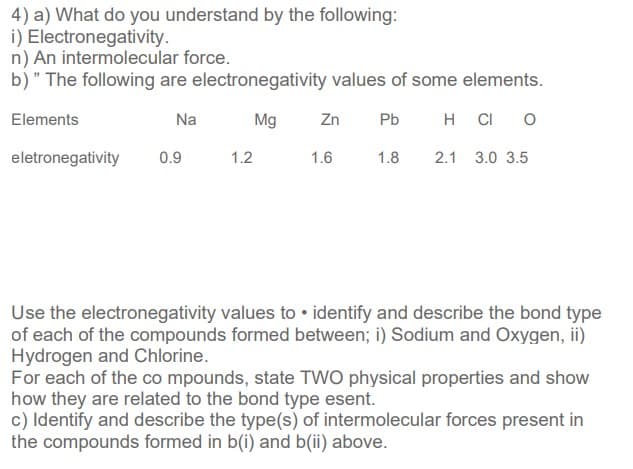4) a) What do you understand by the following: i) Electronegativity. n) An intermolecular force. b)" The following are electronegativity values of some elements. Elements Na Mg Zn Pb H CI eletronegativity 0.9 1.2 1.6 1.8 2.1 3.0 3.5 Use the electronegativity values to • identify and describe the bond type of each of the compounds formed between; i) Sodium and Oxygen, ii) Hydrogen and Chlorine. For each of the co mpounds, state TWO physical properties and show how they are related to the bond type esent. c) Identify and describe the type(s) of intermolecular forces present in the compounds formed in b(i) and b(ii) above.
4) a) What do you understand by the following: i) Electronegativity. n) An intermolecular force. b)" The following are electronegativity values of some elements. Elements Na Mg Zn Pb H CI eletronegativity 0.9 1.2 1.6 1.8 2.1 3.0 3.5 Use the electronegativity values to • identify and describe the bond type of each of the compounds formed between; i) Sodium and Oxygen, ii) Hydrogen and Chlorine. For each of the co mpounds, state TWO physical properties and show how they are related to the bond type esent. c) Identify and describe the type(s) of intermolecular forces present in the compounds formed in b(i) and b(ii) above.
Principles of Modern Chemistry
8th Edition
ISBN:9781305079113
Author:David W. Oxtoby, H. Pat Gillis, Laurie J. Butler
Publisher:David W. Oxtoby, H. Pat Gillis, Laurie J. Butler
Chapter3: Atomic Shells And Classical Models Of Chemical Bonding
Section: Chapter Questions
Problem 99AP: A stable triatomic molecule can be formed that contains one atom each of nitrogen, sulfur, and...
Related questions
Question
Answe b & c

Transcribed Image Text:4) a) What do you understand by the following:
i) Electronegativity.
n) An intermolecular force.
b)" The following are electronegativity values of some elements.
Elements
Na
Mg
Zn
Pb
H
CI
eletronegativity
0.9
1.2
1.6
1.8
2.1 3.0 3.5
Use the electronegativity values to • identify and describe the bond type
of each of the compounds formed between; i) Sodium and Oxygen, ii)
Hydrogen and Chlorine.
For each of the co mpounds, state TWO physical properties and show
how they are related to the bond type esent.
c) Identify and describe the type(s) of intermolecular forces present in
the compounds formed in b(i) and b(ii) above.
Expert Solution
This question has been solved!
Explore an expertly crafted, step-by-step solution for a thorough understanding of key concepts.
Step by step
Solved in 5 steps

Knowledge Booster
Learn more about
Need a deep-dive on the concept behind this application? Look no further. Learn more about this topic, chemistry and related others by exploring similar questions and additional content below.Recommended textbooks for you

Principles of Modern Chemistry
Chemistry
ISBN:
9781305079113
Author:
David W. Oxtoby, H. Pat Gillis, Laurie J. Butler
Publisher:
Cengage Learning

Introductory Chemistry: An Active Learning Approa…
Chemistry
ISBN:
9781305079250
Author:
Mark S. Cracolice, Ed Peters
Publisher:
Cengage Learning

Introductory Chemistry: A Foundation
Chemistry
ISBN:
9781337399425
Author:
Steven S. Zumdahl, Donald J. DeCoste
Publisher:
Cengage Learning

Principles of Modern Chemistry
Chemistry
ISBN:
9781305079113
Author:
David W. Oxtoby, H. Pat Gillis, Laurie J. Butler
Publisher:
Cengage Learning

Introductory Chemistry: An Active Learning Approa…
Chemistry
ISBN:
9781305079250
Author:
Mark S. Cracolice, Ed Peters
Publisher:
Cengage Learning

Introductory Chemistry: A Foundation
Chemistry
ISBN:
9781337399425
Author:
Steven S. Zumdahl, Donald J. DeCoste
Publisher:
Cengage Learning

World of Chemistry, 3rd edition
Chemistry
ISBN:
9781133109655
Author:
Steven S. Zumdahl, Susan L. Zumdahl, Donald J. DeCoste
Publisher:
Brooks / Cole / Cengage Learning

Chemistry for Engineering Students
Chemistry
ISBN:
9781337398909
Author:
Lawrence S. Brown, Tom Holme
Publisher:
Cengage Learning

Chemistry: An Atoms First Approach
Chemistry
ISBN:
9781305079243
Author:
Steven S. Zumdahl, Susan A. Zumdahl
Publisher:
Cengage Learning